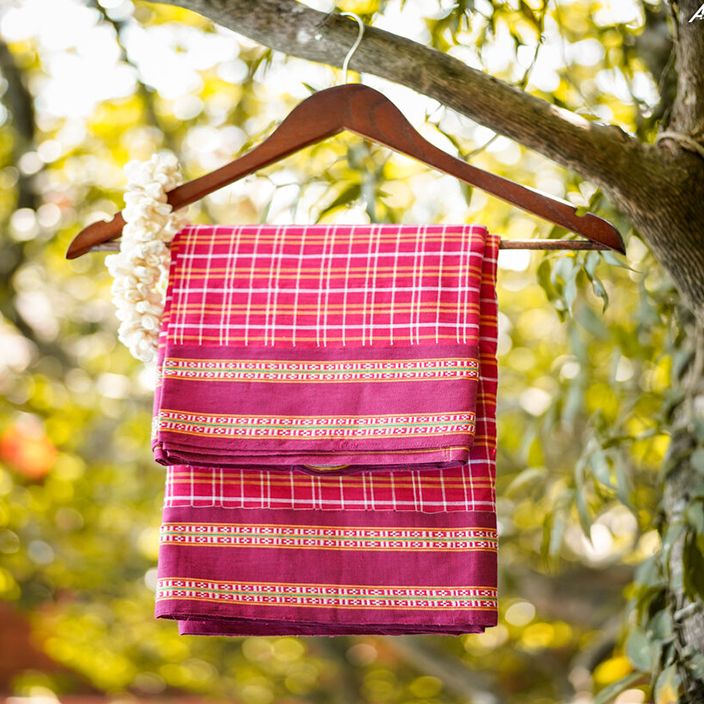For best prices and early deliveries, WhatsApp us at. 918488070070

Kunbi
It is not just the serene landscape of Goa that is exhilarating but also its unique textiles that deserve special recognition. For centuries, Goa has been under diverse cultural influences – especially under the Portuguese rule that heavily influenced Goans in terms of their food, clothing, art, and architecture; the existence of tribal groups in the area, just adds more richness to it. The Kunbi tribe is undoubtedly the oldest known community, who settled in Goa even before the Portuguese came. The kunbi are an integral part of Goa’s history and tribal population. It is their tribal art, culture and food that contributes and adds more to Goa’s essence. These tribal arts come alive during different festivals and occasions, like the Intruz – a five-day carnival, where a number of dance and drama performances are performed by the villagers. The folk dance, music, and unique processions that take place during such festivals are truly a cultural delight. Similarly, the Kunbi Saree is a major aspect of Kunbi Crafts that became an unforgettable inspiration for late Goan designer, Wendell Rodricks. These hand-woven checkered sarees are worn by the Kunbi women, who are majority agriculturalists. With time and recognition from designers like Rodricks himself, the saree grew in popularity and is now regarded as a prime Goan textile.
Tracing Its Origin
The origin of the kunbi saree authentically lies within the kunbi tribe of Goa. The textile is not just a piece of clothing but a lifestyle for the kunbi women who have been known to be agriculturalists, for many generations. These light sarees, worn right below the knee allowed the women to move freely when working in paddy fields and the cotton fabric helped them to keep cool under the scorching heat.
The textile is hence so old that it is almost impossible to point to the exact date and time of its origin but, it has been noted these sarees were worn, even before the Portuguese came to Goa and influenced its textile and clothing market.
How It’s Done
A simple pit loom is used to weave this heritage textile; it has been the norm, for centuries. Only cotton yarns are used to weave these sarees and the quality varies from 20 to 60 counts. Originally, classic checkered patterns were the only one that was produced and finished with a slight heavy dobby border, which is basically a flattened silk inset. Being a rural weave, no silver or gold zari is used but, it is the sheer simplicity of this hand-made textile that gives it so much more gravitas.
Comforting, lightweight, and beautiful- these sarees are worn by farmers, fisher-women and even women of higher status. Traditionally, they were dyed in Naptha colours- red and white colours and that has been the classic colour combination, ever since. Some other colours that are used to weave the checks on the base fabric are, yellow, blue, and green.
But currently, due to the sartorial change of taste in consumers, the colours have been toned down to pastels and other lighter shades. An authentic kunbi textile oozes the influence of tribal ethnicity and simplicity. In fact, an original kunbi saree is unusually short in length, compared to the standard 6 to 9 yards; this allows the hardworking tribal woven, freedom to move around freely and is not restrictive.
Kunbi Today
The kunbi saree has not always had a pleasant journey of its own. The sarees were heavily worn before the Portuguese invasion of Goa but, soon the influence of the new foreign rulers changed the market, the people and their tastes. As a result, kunbi sarees and kashtis faced a considerable downfall during that era and it is not after the Portuguese left Goa- much later in 1960, after those indigenous Goan textiles were revived.
Designer Wendell Rodricks and the Government of Goa, both play important roles in the revival of this fabric in recent times. In an interview, Rodrick explains how he modernized the kunbi saree, by omitting the heavy jacquard border and experimenting with trending pastel shades, while also keeping its originality alive. After the textile made an appearance on the ramps, through Rodrick’s collection – people finally understood and recognized the age-old Indian textile, which was hiding away in the villages of Goa.
Kunbi is an indigenous community of farmers in the Indian state of Maharashtra, known for their traditional attire and cultural practices, while the Kullu shawl is a type of woolen shawl woven in the Kullu district of the northern Indian state of Himachal Pradesh.
Shop Kunbi
One can find the kunbi sarees and other kunbi products by designer Wendell Rodricks at Pernia’s Pop-Up Shop. The serene neutral sarees and dresses are the ideal summer wear and can be sustained for many years. The kurtas for men are an equal delight, where modern meets tradition- comfort and sustainability are just an added bonus!
Image Credits
Asia Inch | Caleidoscope | Civil Society | Cottons Daily | Esamskriti | Facebook-Kunbi Saree | Gaatha | Global Inch | Google Arts and Culture | India Inch | My Grandma’s Legacy | Not Just a Shopper | She the people tv | Textile Value Chain | Whats Hot